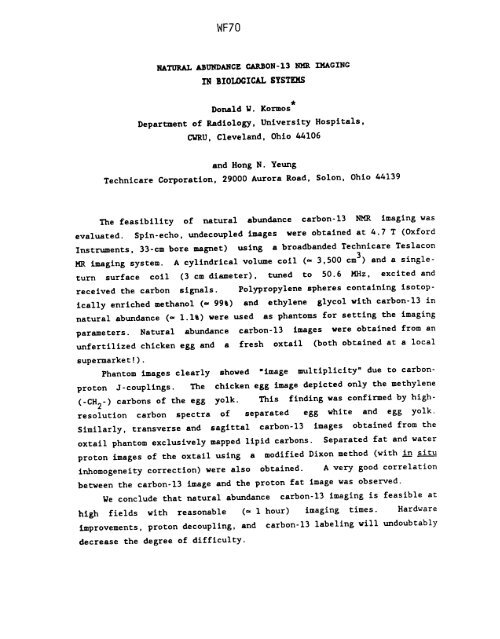th - 1987 - 51st ENC Conference
th - 1987 - 51st ENC Conference
th - 1987 - 51st ENC Conference
You also want an ePaper? Increase the reach of your titles
YUMPU automatically turns print PDFs into web optimized ePapers that Google loves.
WF70<br />
NATURAl, ABUNDANCE CARBON-13 NMR IMAGING<br />
IN BIOLOCICAL SYSTEMS<br />
Donald W. Kormos<br />
Department of Radiology, University Hospitals,<br />
C~RU, Cleveland, Ohio ~I06<br />
and Hong N. Yeung<br />
Technlcare Corporation, 29000 Aurora Road, Solon, Ohio 44139<br />
The feasibility of natural abundance carbon-13 NMR imaging was<br />
evaluated. Spin-echo, undecoupled images were obtained at 4.7 T (Oxford<br />
Instruments, 33-cm bore magnet) using a broadbanded Technicare Teslacon<br />
MR imaging system. A cylindrical volume coll (= 3,500 cm 3) and a single-<br />
turn surface coll (3 cm diameter), tuned to 50.6 MHz, excited and<br />
received <strong>th</strong>e carbon signals. Polypropylene spheres containing isotop-<br />
Ically enriched me<strong>th</strong>anol (= 99%) and e<strong>th</strong>ylene glycol wi<strong>th</strong> carbon-13 in<br />
natural abundance (= 1.1%) were used as phantoms for setting <strong>th</strong>e imaging<br />
parameters. Natural abundance carbon-13 images were obtained from an<br />
unfertilized chicken egg and a fresh oxtail (bo<strong>th</strong> obtained at a local<br />
supermarket!).<br />
Phantom images clearly showed =image multiplicity" due to carbon-<br />
proton J-coupllngs. The chicken egg image depicted only <strong>th</strong>e me<strong>th</strong>ylene<br />
(-CH2-) carbons of <strong>th</strong>e egg yolk. This finding was confirmed by high-<br />
resolution carbon spectra of separated egg white and egg yolk.<br />
Similarly, transverse and saglttal carbon-13 images obtained from <strong>th</strong>e<br />
oxtail phantom exclusively mapped lipid carbons. Separated fat and water<br />
proton images of <strong>th</strong>e oxtail using a modified Dixon me<strong>th</strong>od (wi<strong>th</strong> in situ<br />
inhomogeneity correction) were also obtained. A very good correlation<br />
between <strong>th</strong>e carbon-13 image and <strong>th</strong>e proton fat image was observed.<br />
We conclude <strong>th</strong>at natural abundance carbon-13 imaging is feasible at<br />
high fields wi<strong>th</strong> reasonable (= i hour) imaging times. Hardware<br />
improvements, proton decoupllng, and carbon-13 labeling will undoubtably<br />
decrease <strong>th</strong>e degree of difficulty.













